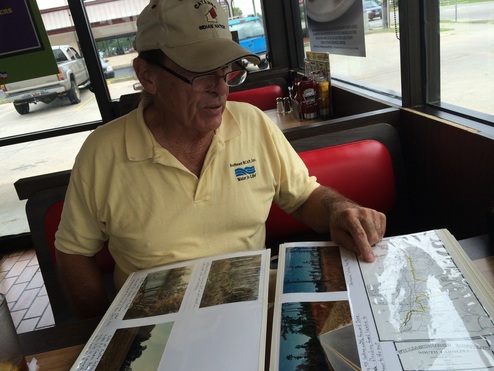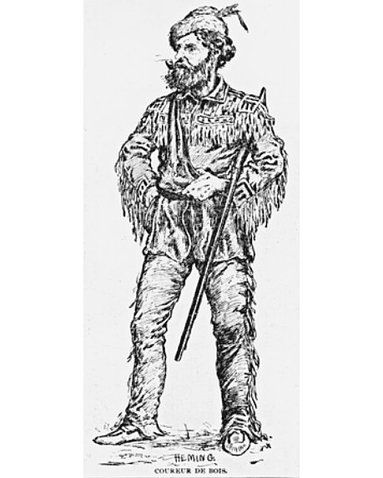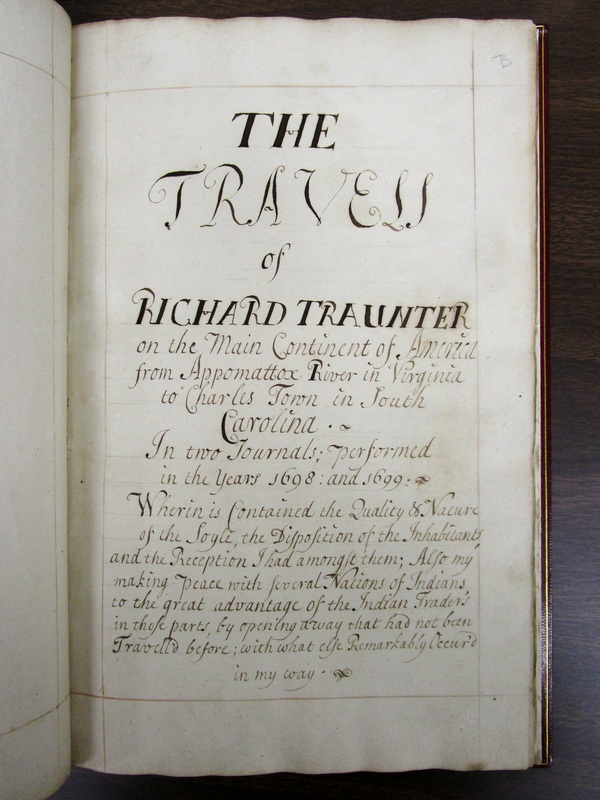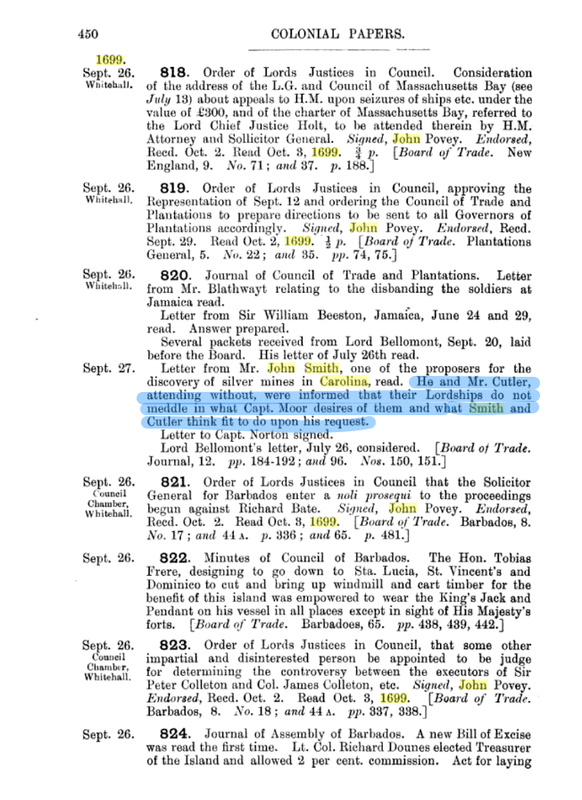 Here's Val, going through his vast store of Lawsoniana for me one day at a Waffle House. I believe I paid for lunch, but my debts to Val remain far from discharged.
Here's Val, going through his vast store of Lawsoniana for me one day at a Waffle House. I believe I paid for lunch, but my debts to Val remain far from discharged. Here's the story. Since Lawson wrote his book, people have wondered who he traveled with. He tells us he began his voyage "being six English-men in Company, with three Indian-men, and one Woman, Wife to our Indian-Guide." He makes various references to his companions hither and yon, but basically nobody has ever come close to even imagining they could find information on who Lawson went with on his trip.
As I say, enter Val. Val, as I tell you in the piece linked above, is a retired sewer engineer in South Carolina who, forty years ago, received a copy of Lawson's A New Voyage to Carolina for his birthday, got interested in where Lawson went -- I mean exactly where, step by step -- and began thinking and drawing conclusions. Val has been my guide, my source, my rabbi throughout this project; pretty much everything I know I know from Val, and regarding Lawson if Val doesn't know it, chances are nobody knows it.
So one day, someone in the library of the Virginia Historical Society noticed that their collection included a manuscript by one Richard Traunter, who describes traveling between Fort Henry in the Virginia colony and Charles-Town, in Carolina, by land -- in 1698 and 1699, a couple years before Lawson's famous journey in 1700-1701. The manuscript was bequeathed to the library in 1999 with the collection of Paul Mellon and has been cited once or twice -- in Indian Slavery in Colonial America, for example, and The Goose Creek Bridge: Gateway to Sacred Places. But it's unpublished: if you don't go looking for it in the Virginia Historical Society, you don't read it.
Anyhow, someone at the library sent a copy of the typed transcript of Traunter's handwritten journal to Chester DePratter, archaologist at the University of South Carolina -- where it sat on the corner of his desk, possibly for years. One day when Val was in DePratter's office, according to Val, DePratter handed him the typescript, saying he wondered whether it might help Val with his ongoing Lawson research.
Well, you might say.
Val, as I have said elsewhere, does the kind of primary-source research that gets Ph.D.s for mere mortals, and Val started looking into things, and here's what Val has discovered, using Traunter's manuscript, letters between Carolina colonists like Thomas Cutler and eventual governor James Moore and the Lords of Trade that reside in the British Public Records Office, and forty years' worth of thinking. I should note right here: I've chased down many of the records Val cites, and I'm convinced. I think Val is right.
Here goes. Traunter, an Indian trader in the employ of Robert Byrd at Fort Henry on the falls of the James River in Virginia (it's Petersburg now), set out in 1698 for Charles-Town, for what he describes as two motives: one, "from a Naturall propensity I always had to travel; but more especially in untroden paths, thoroly to discover thye wonderfull workes of the Almighty brought forth by Nature, as well to Enlighten the Intellect, As to gratifie the externall Senses." His other goal, he says, was to "Apply my discoveris & Travels to the common Good of my Country, soe as to make them Usefull to the Traders to those places I passed through."
Traunter describes a 1697 attempt to make the same trip that met with catastrophe when the party was set upon by hostile Occaneechee Indians (who then still lived in Virginia), killing one of the traders and injuring an Indian slave of James Moore from Charles-Town, "Indian Jacke" (Lawson too rarely refers to Indians by their own names: Santee Jack, Keyauwee Jack, Eno Will and his son Jack; you don't even get your real name being just another sweet little piece of conquest). Anyhow, Indian Jack wishing to return to Moore, Traunter is just the fellow to make the journey with him.
So off they go. They make their way safely all the way down to Charles-Town, or anyhow to Goose Creek, where Moore hangs out, north of Charles-Town, arriving in September, 1698. Once there Traunter falls in with Moore and his associates, then planning a journey to the mountains looking for gold -- Moore had made such a journey in 1690, claiming to have found "seven sorts of ores or mineral stones," though what with the French and Spanish nearby he had thought it best to keep it a secret until 1699, when he reached out to the Lords of Trade asking for backing for further expeditions.
Traunter sails back to Virginia, then makes a second journey much like the first in 1699, ending up back in Charles-Town in October, 1699.
Moore sends out that second expedition after gold, including one of the greatest Indian traders of the day, Jean Couture. It fails when one of the main explorers drowns. Undaunted, Moore, sure that with the untold riches to come the Lords of Trade would want to back his scheme to send dozens of explorers and Indians to the mountains to look again for gold, sends that letter asking for backing.
| Their Lordships are not impressed. "Their Lordships do not meddle in what Capt. Moor desires of them and what Smith and Cutler think fit to do upon his request." Okay: Smith and Cutler? Those two are described as "attending without" their Lordships' offices as they met, in September of 1699. Smith was a trader named John Smith, and Cutler was Thomas Cutler, a friend of Moore's and the business partner of a Londoner named Henry Netherton, for whom he investigated Indian trading and mining opportunities in Carolina, where he had arrived in 1698. Note: this all took place in late 1699 -- and a few months later our own John Lawson in London "accidentally met with a Gentleman, who had been Abroad, and was very well acquainted with the Ways of Living in both Indies; ... he assur'd me, that Carolina was the best Country I could go to." Beginning to draw the strings together? Here it is, as plain as I can get it. |
 Here's a coureur des bois (a "runner through the woods," which is what the French called Indian traders like Couture).
Here's a coureur des bois (a "runner through the woods," which is what the French called Indian traders like Couture). Add in that Londoner Netherton's wastrel son has arrived in Charles-Town, where he immediately sets about asking for money, according to a letter from Moore to Cutler dated Dec. 27, 1700, to pay for his freight and "to buy a servant woman," with whom "he had kept company all voyage." Moore irritatedly notes that "Mr. Netherton is by land on his way to Virginia."
You with us?
That letter was dated Dec. 27, 1700. And we have Lawson's note that he -- traveling with five other Europeans and four Indians -- left on Dec. 28 for Virginia, traveling by land (though the first week had them moving by canoe). Couture, by the way, had made it to Charles-Town via the Savannah River and then up the coast, and Traunter, as we know, had made his way more easily to Goose Creek than to Charles-Town. So parts of the passage remained unresolved, which renders perfectly reasonable Lawson's group's choice to travel the first week by canoe along the coast, until they reached the Santee River, by which they would find Indian trails.
So here are Val's conclusions -- to which, once again, I wholly ascribe, and which nobody in this world before Val Green has drawn.
Lawson meets Cutler in London; Cutler tells Lawson, "Go west, young man" -- and sends him to Charles-Town to be introduced to Moore and everyone else. Meanwhile, there's Traunter, hanging around town, along with Couture looking for what's next. Lawson, Couture, Traunter -- that's three. Add in Netherton, traveling "by land on his way to Virginia" about the exact day Lawson started, and you're up to four. Traunter makes clear he never traveled alone, so poking around in various lists of traders from Virginia, Val finds one John Evans, Jr., also known as "Trader John Evans," who Val says eventually bought property in South Carolina. Which leaves room for only one more. Val believes that to be a member of the LeGare family, one of Charleston's founding families. Solomon LeGare, born 1670 and arrived in Charleston in 1686, would fit right in, especially since one member of the group, once they've passed through the swamps near the coast, decides he cannot continue but must return: "we went forward, leaving the poor dejected Traveller with Tears in his Eyes, to return to Charles-Town," Lawson says. And in a letter requesting a grant from the Lords of Trade, Traunter and his associate Edward Loughton (by the way, brother-in-law of Cutler) include among the people they plan to go prospecting with Couture, Netherton, and Solomon LeGare.
So again, of these last two, like Val, I'm less certain -- one might easily include Smith instead of Evans, and LeGare, already a Charleston stalwart and part of Netherton and Coutur's prospecting cabal, could easily have chosen to go -- and then turned back. Val mentions another LeGare, one Simon, who he says shows up coming south with Traunter and also fits the bill.
Nice enough, but what makes this stuff work for me is the corroborations you find within Lawson. Lawson frankly describes the general practice of the Indians providing bedfellows for the traders who want them, though most of his group appears to deny itself this pleasure. But he accounts with special glee one member of his group "having a great Mind for an Indian Lass, for his Bed-Fellow that Night" -- the same member having been frustrated among a previous group of Indians by an old and ugly woman who bunked with them, ruining his chances. That fellow purchases the services of his lady and off they go. Lawson and the rest go to sleep. Lawson describes what happens next:
"About an Hour before day, I awak'd, and saw somebody walking up and down the Room in a seemingly deep Melancholy. I call'd out to know who it was, and it prov'd to be Mr. Bridegroom, who in less than 12 Hours, was Batchelor, Husband, and Widdower, his dear Spouse having pick'd his Pocket of the Beads, Cadis, and what else should have gratified the Indians for the Victuals we receiv'd of them. However that did not serve herturn,but she had also got his Shooes away, which he had made the Night before, of a drest Buck-Skin. Thus dearly did our Spark already repent his new Bargain, walking bare-foot, in his Penitentials, like some poor Pilgrim to Loretto."
To me that sounds like every adventure of every wastrel son, sent by a frustrated father to his partner to make something of himself and instantly getting into trouble. Add in that, according to the record, Netherton the younger ultimately married a Virginia heiress and you're telling a story familiar to everyone who ever went to college with a screwup scion of some rich family who nonetheless, with privilege on his side, always seemed to have things work out just fine.
Regarding Couture, Lawson says of one of his travel partners, "That one of the Cabins was his Father's-in-Law; he call'd him so, by Reason the old Man had given him a youngIndian Girl, that was his Daughter, to lie with him, make Bread, and to be necessary in what she was capable to assist him in, during his Abode amongst them." A trader with this strong of a relationship with the Indians near Charleston of course doesn't need to be Couture -- but Couture fits the bill. On his journey Lawson often mentions the opinions of traders, so he was clearly traveling with some. Couture and Traunter? Why not? Lawson mentions that the wild fig grows in Virginia, which he has from "a person of Credit, and a great Traveler in America;" and few in South Carolina would have then known as much about Virginia as Traunter. When speaking of buffalo, which Lawson has not seen, he describes them but cites "a Traveller of Credit," which might describe Couture, who had traveled with LaSalle and was familiar with lands as far west as the Mississippi. In a letter to the Lords of Trade John Smith describes Traunter as "one of the Greatest Travellers amongst the Indians"; in the letter asking for a grant, Traunter and Loughton call Couture "the greatest Trader and Traveller amongst the Indians for more than Twenty years."
Yes: to be sure; this is conjecture. And yes, if you work at it you can probably poke holes.
But let's start with the basics: with a couple exceptions, nobody has tried to gain anything from Traunter's narrative for 300 years, and starting with that Val Green has drawn amazing conclusions. Second, given how Lawson and Traunter follow so much of the same path, it seems absurd not to conclude that Traunter traveled with Lawson. Once you've included Traunter and recognized that the group was planning an enterprise together, Couture and Netherton follow almost certainly, especially since we know Netherton left for Virginia at exactly that time. LeGare? Well, he was in the group planning, so... ; as for Evans -- or Smith -- there's plenty of question. But until Val Green came along we had Lawson and five question marks. I'm pretty convinced we've now got Lawson, Traunter, Couture, and Netherton. As for the other two we'll see. In any case, I say hurray for Val Green.


 RSS Feed
RSS Feed